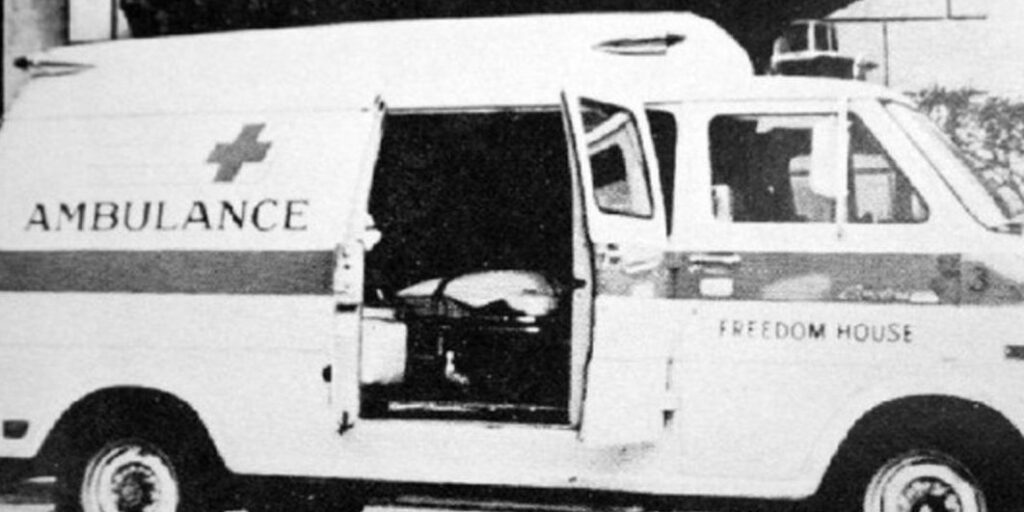In celebration of Black History Month, Team Rubicon is sharing the stories of Black trailblazers in our line of work: emergency management and disaster response. One group whose work has had a profound impact on the world’s Emergency Medical Service systems is the trailblazing Freedom House Ambulance Service.
Founded in 1967 by the Pittsburgh civil rights organization Freedom House, which offered job training and assistance to Black Pittsburghers, the Freedom House Ambulance Service was created largely to serve the predominantly Black community of the Hill District.

Prior to the mid-1960s, most ambulance services in the city were provided by the police, who would typically rush people to the hospital in the back of a police van. During an emergency, many residents of the Hill District were reluctant to call the primarily white Pittsburgh police force. When they did call, the police were often slow to respond. These racial tensions existed against the backdrop of a community that desperately needed emergency medical care. George McCrary, a Freedom House paramedic, describes the Hill District of the ’60s and ’70s, saying, “People had seizures, strokes, gunshots, stabbings, heart attacks, the whole nine yards, right here in this area.”
As it sought to address the need in the Hill District and launch the ambulance service, Freedom House began by recruiting would-be paramedics from within the community, including many who had experienced long-term unemployment, had criminal records, or were veterans of the Vietnam War. Freedom House worked closely with Dr. Peter Safar, known as the “Father of CPR,” to design and implement a revolutionary 32-week training program that would turn these recruits from the Hill District into the world’s first-ever first responders.
The recruits’ training included 300 hours of anatomy, physiology, CPR, advanced first aid, nursing, and defensive driving instruction. Once they were on the road, the Freedom House ambulances became the first emergency medical service in the United States to be staffed by paramedics with medical training beyond basic first aid.

Deployed at first in donated and refitted ambulances, the Freedom House paramedics were soon breaking medical ground by offering unheard-of emergency care to patients while en route to the hospital. In the Hill District, where slow ambulance response times had once been a source of contention between residents and police, the Freedom House ambulances had a typical response time of less than 10 minutes.
During its first year of operation, the Freedom House Ambulance Service responded to nearly 5,800 calls and transported more than 4,600 patients, and, according to data collected by Dr. Safar, its paramedics saved 200 lives.
Gene Starzenski, the filmmaker of the 2009 documentary “Freedom House: Street Saviors,” witnessed the work of the Freedom House paramedics firsthand and attributes their effectiveness to their compassion for the community.
“That’s the number one thing they brought to the table,” Starzenski says, “they cared.”

Even as they faced racism from hospitals, patients, and local government, Freedom House paramedics came to be known for the high standard of care they provided. Eventually, even the police began requesting them for urgent, life-threatening calls throughout the city.
Freedom House Ambulance Service Paves Way for EMS to Come
As Freedom House became a leader for ambulance services in the U.S. and internationally, they helped develop the first national training standards for paramedics and the first nationally recognized design for ambulances. By 1975, Freedom House had instituted ongoing training for their paramedics in unprecedented areas such as intubation, cardiac care, and IV drug administration. That year, when the U.S. Department of Transportation and the White House came together to form an interagency council on Emergency Medical Services, it adopted Freedom House’s training regimen as their pilot course. Thus, the innovative techniques that the Freedom House paramedics had pioneered became the national training model for EMS programs in the U.S.
Though highly regarded throughout the medical field and beloved by residents of the Hill District, the Freedom House Ambulance Service was forced to stop operation at the end of 1975 when the mayor of Pittsburgh instituted a citywide ambulance service. Most of the Black paramedics who had served on the ambulance crews for Freedom House were excluded from comparable work within the new system.
The legacy of the Freedom House Ambulance Service lives on in the training that today’s first responders receive and the high quality of medical care that they give their patients. By refusing the status quo and raising the standard of care in their own community, the Black paramedics at Freedom House raised the standard of care for all.




